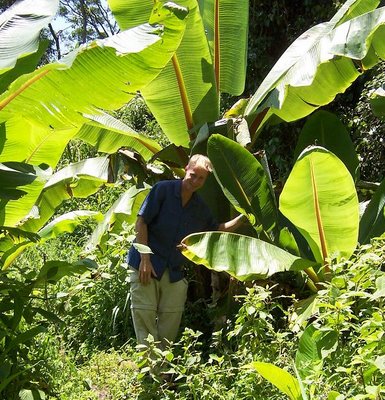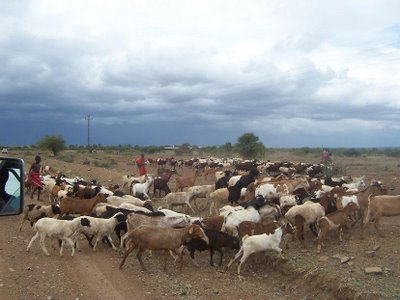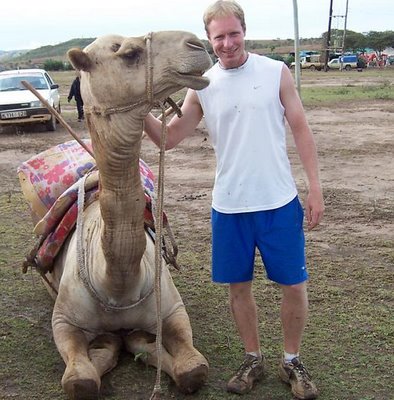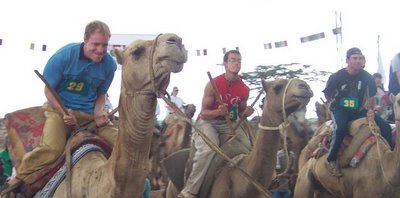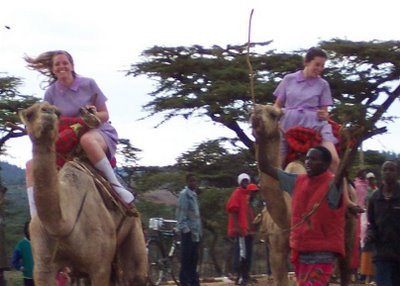I finally made it back to civilization after one of the 5 most memorable experiences of my life. For those of you who don’t want the detailed account, here’s a quick summary of what I took home this weekend: 1st Place Camel-athlon, 3rd Place Amateur Camel, DNF (Did not finish) Professional Mountain Bike Race, 13500/= (almost $200) in prize money, cactus-related injuries, and a severely battered body. I’ll be away from site for the next 3 weeks, and it’s a pity because I don’t have my camera cable with me. The pics are great.
Anyway, I spent the last week getting things in order for my upcoming adventures and think things in Kakamega will be fine until I return. I keep finding cash crops with a lot of potential, and in September I’ll be busy learning about the markets and spreading the word to the Network. In the meantime my time away from site is off to a great start. Six of the FSD (Foundation for Sustainable Development) volunteers that I have become friends with joined me for the camel derby, and we left Thursday Afternoon for Nakuru, the midway point between Kakamega and Maralal. A map will show a much shorter route, but I was warned by many and forbidden by Peace Corps to take it due to recent skirmishes with Pokot-tribe bandits and automatic weapons. We were limited on time and decided to go by matatu from Kakamega to Nakuru instead of bus, which was a genuinely terrifying experience. The road is just pathetic and Kenyan has some terrible drivers. We were going down one particularly treacherous hill, and a BMW came bearing down on us after trying to pass three trucks on a blind curve. Luckily it swerved off the road and barely missed us, while the guy driving the Bimmer smiled and waved like it was no big deal at all. Several similar experiences left me vowing to avoid matatus on the Kisumu-Mombassa route whenever possible, while Laura, one of the FSD volunteers, sat in the front seat and screamed at the driver every time he tried to pass anyone.
We finally made it to Nakuru and stayed at the Mt Sinai Hotel, which for about $2 per person isn’t bad as long as you are not bothered by wet, dirty towels (I don’t even want to know about the sheets), no soap or toilet paper, and a freezing cold shower that doesn’t work in the morning. On the plus side we were given rooms on the roof with a great view of Lake Nakuru, and the nearby restaurant, called Subway but in no way related to the chain, had some of the best food for the money I’ve eaten here.
The highlight of the following day was the six-hour trek into the wilderness of Northern Kenya. We started with a matatu to Nyaharuru, which was one of the most beautiful drives I’ve been on. We drove along the rim of the Rift Valley and looked down at a spectacular panoramic view of rolling green hills dotted with Acacia trees and tin-roofed houses. An hour later we climbed out of the valley into fertile plains and the town of Nyaharuru. The more I travel in this country the more I realize how fortunate I am to be here. Peace Corps volunteers living in places like Mali have practically the same scenery everywhere they go, whereas I am doubtful anywhere else in the world has as much scenic diversity and beauty in such a small area as Kenya.
Nyaharuru is a nice town with a beautiful waterfall called Thomson’s Falls. I was able to see it on the return trip but the trek to Maralal was a huge hassle, as everyone went their separate ways in Nyaharuru to buy groceries, use the ATM, and wander around. Large groups of people are so difficult to organize and I was getting frustrated as the only bus of the day pulled out of the stage to Maralal before we had everyone together. We ended up renting a private matatu because there was no other way we would be in Maralal in time for the derby. Noel, one of the FSD volunteers, is fantastic at bargaining prices and she was able to convince the driver to take us for almost the same price as if we were using a public vehicle, while he initially wanted to charge us triple the cost.
We started the ride to Maralal on a freshly paved road and were surprised that roads in this part of the country were well maintained. Then, thirty minutes later, we got what we expected: bumpy dirt (and eventually mud) roads for the next four hours. As random pieces continued to rattle of the matatu, it was incredible watching the scenery change around us. The foliage continued to grow sparser and the plains, covered with cactus trees, thorn bushes, and prickly shrubs stretched to the horizon. Surprisingly, it was on this terrain that I saw my first elephants. Scraggly trees broken to pieces from elephant damage started to appear and then in the nearby distance we saw a very large herd of elephants. Like the hippos, they were absolutely enormous and larger than what I have seen in the zoo.
After passing the elephants the landscape grew more barren, and among the sparse trees and bushes were herds of cattle, sheep, and goats. Guiding these herds were the Samburu people. They are closely related to Masai and are nomadic pastoralists who have maintained their traditions despite the influence Western culture has had on the majority of the people in the world. They wear traditional clothing, which in most cases consists of brightly colored robes and beautiful, ornate beaded jewelry. The women wear thick rings of beads around their necks, and both men and women have elongated ear lobes. Their skin tone is ebony black and the women are tall, slender, and graceful. The Samburu diet consists almost entirely of milk and meat, as very little vegetation edible for humans can grow in the area. We saw several groups of Samburu herding their animals down the road, and we were told many of them are fleeing from Pokots, who are using machine guns to steal cattle from neighboring tribes.
Finally, after hours of driving though the bush, we began seeing camels in the distance and realized we were close to Maralal. There is very little rainfall in this part of the country, but for some reason there were scatted rainstorms the entire time I was there. We even had to wait for some time to cross one particular section of road that had become a river. While waiting for other vehicles to cross I realized there was about a 50/50 chance of becoming stuck in the middle, as half the vehicles crossing stalled. Luckily we made it and finally I arrived at the Yare Camel Club and Campsite. I played a game of Ultimate Frisbee, registered for the Camel-athlon, and finally called it an evening.
My intention was to do the Camel-athlon only. It was significantly less expensive to register for than the Camel-only race, and I was trying to watch what I spent. Then I realized that most of the Peace Corps volunteers who had come to the event weren’t going to do anything but watch, and some of the Samburu people had been walking through the desert for over a month to be in Maralal to rent their camels for the event. Since the intention of the Camel derby is for it to be an income generating activity for the Samburu people, at the last minute I decided to do the Camel race as well.
The first thing I noticed about camels, besides how ugly they are up close, is that they hate people. They bite, they make a horrible throaty-gurgling sound, and the only way to get them to move at all is to beat the heck out of them with a stick. The next thing I realized is that the top of a camel’s hump is way too high. I was at least 12 feet off the ground sitting on a moldy couch cushion strapped around the camel’s hump with rope. Two large branches tied to the animal’s sides functioned as support, and it was a challenge just to stay in place. In fact, one guy was thrown off the camel at the very start of the race and staggered off deciding to no longer participate in the event. As for me, I hung on tenaciously while Charles, my Samburu camel handler, ran behind me smacking the camel in the butt with a stick. Occasionally the apathetic camel would grumble and stop moving, and no amount of additional stick-whacking would get it to move. Then, a few swift jabs between the hind legs were enough to get it going again.
Things were going great at first. I promised Charles a healthy tip if my camel won, and he was determined to have the winning camel. For the first part of the race I was in first place, and then I was passed by a kid that had six people surrounding his camel and whacking it. Apparently the fastest camel is the one that is beaten the most, because there was no way I could keep up. Then the rain started. Something else I learned last weekend: camels HATE water. Despite all the stick whacking, the race pretty much came to a halt until the rain let up. Even after the showers the camel was hesitant to move, and I quickly learned why. Camels have no traction for wet ground, and the entire pack was slipping and sliding across the race track. Off in the distance the first place camel slid sideways and dumped the rider, and for a brief while I was in first place. Unfortunately the first place camel was down but not out, and near the finish line he gained the lead again. As I approached the finish line I was in second place out of at least 40 camels, when a slippery puddle just a few meters from the finish line tripped my camel up. We slid and fell over, and as I remounted the camel and yelled a camel came from behind and took second place. My camel made third, which was still a good showing and made me 10,000/= richer.
After the camel race I felt like I had been severely beaten. My shoulder blades and arms hurt from trying to stay in place for the hour-long 10k ride, my feet were rubbed raw from chafing against the rope (never wear sandals when riding a camel), and most of all my butt and lower back hurt from trying to sit on top of the thing. I kept sliding off the camel to the bottom of the hump where it was more comfortable, but my handler would yell at me to get back on the top. Even as I sit here five days later I am still sore. Honestly there is no way I am going to ride a camel again, and those camel safaris through the desert that used to sound so fun sound like absolute hell now.
Regardless, I had registered for the Camel-athlon and was determined to follow through with it. It was only a 3k camel ride and I decided to tough it out. The Camel-athlon was divided into two groups: a team that consisted of 3 professionals (one runner, one camel rider, and one cyclist) and a novice class that completed the entire event with a single person. The race was fairly easy, with only a 5k run, a 10k bike ride, and a 3k camel. Several of the girls I traveled with decided to dress up for the event and wore Kenyan school girl uniforms that looked ridiculous. As for me, I decided to go for the prize money and I took the event seriously. The individuals ran alongside the teams and I did my best trying to keep up with the team runners. Something I’ve learned is that you will never, ever win again a skinny tall Kenyan in a matching spandex track suit. The winning guy had to have been running sub-five minute miles, and he left a road-runner like trail of dust behind him as he left me far behind. On a positive note, I was the fasted mzungu on the course and finished first place for the individual event and another 3500/= up. It helped that I had my champion camel and handler helping me through the final stretch.
That night I had a delicious camel burger for dinner. If it wanted to bite me I figured I may as well bite it too. Then I passed out at 9:00 feeling like a dead man. I slept restlessly as I could not find a comfortable position, and when I did doze off I dreamt I was in a boxing match and loosing badly. The next day I could hardly walk and popped a few Tylenol, which helped. The problem was that a 42km professional mountain bike race was scheduled that day, and I had found someone willing to lend me a nice Gary Fisher bike for the event. Honestly there was no way I could say no to a mountain bike race in Northern Kenya and decided to give it a shot despite my broken body. The race started off well, although of course the spandex-wearing skinny Kenyans were far in the lead. Nevertheless, I wasn’t in last place, and all I wanted to do was finish the race anyway. About 10 minutes into the race the rain came back, and it wasn’t long before I was covered head to toe in muck, which isn’t too bad in itself. Things didn’t become extremely unpleasant until about halfway through the race, when a shallow looking puddle turned out to be three feet deep. It swallowed my bike and threw me over the handlebars. I hopped back on a bit bruised but with no serious injuries, and kept peddling through the mud. Eventually things became so mucky that I had to push my bike instead of ride it, and at one point I lost traction and slid into a cactus. I actually had a cactus branch break off and remain stuck in my stomach, as well as blood pouring out of my arm from various puncture wounds. Muddy, beaten, bruised, and bloody I finally decided to quit 25km into the race. The remaining 20km consisted of five loops around a campground that was so muddy it had basically become a sloppy foot race while dragging the bikes through various mudholes. I finally couldn’t take anymore and walked off the course while cameras from Kenya National Television zoomed in on me. Now the whole country knows I am a quitter. Regardless, I was in the race to ride a bike and I wasn’t going to win, so why trudge a bike through mud for the next two hours? Personal challenge be damned, I had already won a camel-althlon the day before.
After the bike race I stuck around for prize money and awards, and was able to find a ride out of the desert the next morning. I made it as far as Nakuru, spent the night once more at the lovely Mt. Sinai Hotel, and have spent the last two days in Nairobi. I’ve done a lot of work on wheelchairs and for the network since I arrived, but I’ll save that for another day. As for now I’m about to catch the night bus to the coast and God willing I’ll be in Mombasa by morning. I’ll write again soon!



